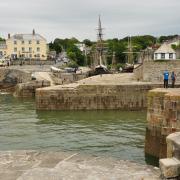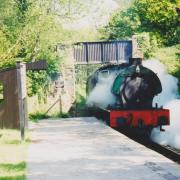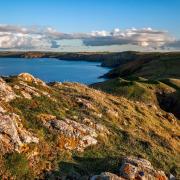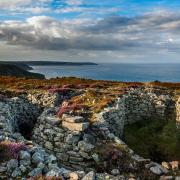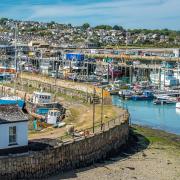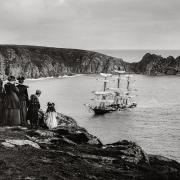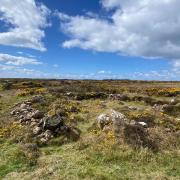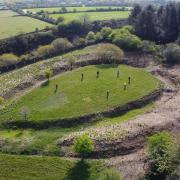SUSAN GRIFFIN examines the role and influence of the Duchy of Cornwall, and discovers how it is evolving with the times to stay relevant and modern
This year marks the Platinum Jubilee, an impressive and unrivalled milestone for Queen Elizabeth II, who became Monarch 70 years ago.
It’s a chance to celebrate and honour a long and dutiful reign but also reminds us of the unavoidable passage of time and prompts questions as to what the future might hold for the Royal Family when Prince Charles succeeds to the throne.
We believe he will move from Clarence House to Buckingham Palace when he becomes King, and that the Queen has given his wife Camilla her blessing to become Queen Consort, but there will also inevitably be a redistribution of titles, including his current title of Duke of Cornwall, which will automatically pass to his eldest son, The Duke of Cambridge.
%image(15712193, type="article-full", alt="The Duke of Cornwall in the Bumblebee Garden at the Duchy of Cornwall Nursery.")
He won’t only inherit the name, however, but the Duchy of Cornwall itself, a private estate covering around 53,000 hectares of land across 23 counties, predominantly in the South West, which encompasses farmland, forests, and coastline, as well as residential and commercial properties.
In Cornwall alone - arguably its spiritual home - there are developments in Truro and Newquay, the Duchy of Cornwall Nursery at Lostwithiel and holiday cottages dotted throughout the county and the Isles of Scilly.
The Origins
The Duchy dates back to the 14th century when it was established by Edward III in 1337 to provide an income for the Black Prince, his son and heir.
Since then, the eldest son of every Monarch has been bestowed the title, and when there hasn’t been a son, as with the Queen, who was one of two daughters, it’s passed to the Sovereign.
The Duke was only three when his mother acceded the throne in 1952, making him the 24th Duke of Cornwall, although he wasn’t entitled to the full income of the Duchy until he turned 21 in 1969 when he took charge of its management.
It’s been an integral part of his life ever since, and in turn, he’s made an undeniable impact as the longest serving Duke in the estate’s history, making it an incredibly successful business with land and assets worth around £1billion.
%image(15712194, type="article-full", alt="The Prince of Wales on a visit to Nansledan.")
In 2019, ITV aired a two-part documentary called Prince Charles: Inside the Duchy of Cornwall (currently available to stream on the ITV Hub). It provided an insight into how the estate works, and followed Prince Charles as he chaired a bi-annual meeting of the Duchy’s Council, or Prince’s Council. Made up of experts in agriculture, finance and law, the group congregates at 10 Buckingham Gate, the Duchy’s head office, to discuss the estate’s current and future operations.
Viewers also learnt more about the Duchy’s financial facets. As stated within the original charter, The Duke of Cornwall isn’t entitled to the proceeds or profit on the sale of the estate’s assets, instead he receives the annual income they generate (which is voluntarily subject to income tax). Today, that equates to yearly profits of around £21million, which funds The Duke of Cornwall, his immediate family, and his charitable work.
One might presume a considerable chunk of the Duchy’s net worth is derived from farming and agriculture given its close association with rural communities.
It holds around 700 farming tenancies, many of which have been passed down through generations, mirroring how the estate has been passed from one Duke to the next.
The Duchy also supports farmers who are keen to maintain traditional methods, and provides opportunities and support for those don’t come from farming stock but want to run their own smallholding. The Duke himself rented over 1,000 acres of land from the Duchy for Home Farm in Gloucestershire, where he trailblazed organic farming three decades ago.
But the reality is farming contributes a small proportion of the Duchy’s income.
The bulk of the estate’s multimillion pound profits are derived from commercial property and urban investments; however, sustainability remains the cornerstone of the Duchy’s activities.
As laid out on the Duchy of Cornwall’s website, the estate has made a commitment to various initiatives, such as reaching net zero across its portfolio, optimising soil management, protecting environmental assets and encouraging communities to live more sustainably as exemplified in the Duchy’s ‘utopian’ developments of Poundbury in Dorset and Cornwall’s Nansledan.
%image(15712195, type="article-full", alt="Nansldean is an urban extension on Duchy land near Newquay.")
The Visionary Towns
The current Duke of Cornwall didn’t have the luxury of an extended apprenticeship as his son does, but forged his own path, and hasn’t been afraid to push the boundaries of what’s possible, even if it has been deemed controversial, such as Poundbury, an extension of Dorchester.
Created to combat the ill-conceived and aesthetically depressing post-war housing developments, Poundbury adheres to four key principles: architecture of place, integrated affordable housing, mixed-use and walkable community.
Founded on Duchy land in 1993, and due to be completed in four years’ time, Poundbury is home to more than 200 local businesses and will have around 2,700 homes in a mix of private and affordable housing when it’s completed in four years’ time.
In the early years, naysayers dubbed it soulless, questioning the stringent rules, such as the colours you’re allowed to paint your house, and likening it to the town in The Truman Show film, which transpires to be a reality show set.
%image(15712196, type="article-full", alt="Ben Murphy, estates director for the Duchy of Cornwall: "It’s a pleasure and a privilege to do this job for HRH."")
But it also has its admirers who’ve praised the sustainable initiatives, sense of community and forward-thinking approach. It’s also inspired Nansldean, which means ‘broad valley’ in Cornish, an urban extension on Duchy land near Newquay.
“I knew of Poundbury from an academic angle as an exemplar project which was influencing the way we build communities in a really positive way, and the principles behind that, but I didn’t really know how successful it was until I applied for the role,” says Ben Murphy, estates director for the Duchy of Cornwall since 2014, which makes him responsible for the Duchy’s sustainable development projects, including Nansledan.
“It’s a pleasure and a privilege to do this job for HRH. There are obvious pressures with developments on this scale to bring things in on time and budget and working to His Royal Highness’ exacting standards, but it’s a genuinely exciting vision and community development is something I’m deeply passionate about.”
Given the Duchy is primarily a rural estate focused on land stewardship, it does not actively promote its land for development, but when Cornwall’s local planning authority earmarked Newquay as a priority for housing growth and regeneration, the Duchy decided to take an active role in helping deliver more sustainable development.
“The Duchy owns a lot of land around Newquay, and so in response to Cornwall County’s plans we held an enquiry-by-design with local people, to find out what they, and the town needed.
“We originally contemplated 400 homes, but as the scale of the ambition grew with meeting various local needs, the masterplan expanded to 4,000 homes of all types and a wide range of business and community uses across 540 acres, with the same aim as Poundbury, of creating one job for every home built,” says Ben.
%image(15712197, type="article-full", alt="Chloe Stock and Jimmy Blick run the Shiva Yoga Studio and Cafe in Nansledan.")
Due to be completed by 2050, so far 530 homes have been built in what’s described as “a mixed-use, mixed-income community”, where 30 per cent of those homes are affordable housing.
They’re also looking to provide rented housing available in Newquay to locals who aren’t in the position to buy their own property and unable to qualify for affordable housing.
“We’ve noticed there isn’t much private rental housing because so many are being used as Airbnb. It’s why we restrict people buying houses to rent as holiday accommodation because Nansledan aims to deliver local needs and we want the people living here to have a stake in their community. It’s also why we encourage exciting local independent artisans to Nansledan, the type of businesses you’d like to live near and visit.”
One of the 30 or small businesses established at Nansledan is Shiva Studio and Cafe, which opened almost two years ago.
“We’ve been overwhelmed by the support of the neighbourhood,” says owner Chloe Stock. “The residents have been so welcoming, and we feel there is a really lovely community growing here. The independent businesses that have set up are all really supportive of each other and we are so grateful to be a part of this growing Duchy estate. It’s such a lovely environment. It’s a little haven for local people.”
Among the next stages at Nansledan is a nursery to complement Skol Nansledan, a 420-pupil primary school, which opened in 2019. This will border a ‘French Square’ of trees with a restaurant-cafe and other retail and offices.
The Duchy is also planning to deliver a new high street, called Market Street, between 2023 and 2028, which is believed to be the first built in the UK for over 150 years.
“There is not a huge appetite in the market for building retail at present, but Market Street will be special, an exciting destination with a new strategic route that will ease traffic in town and help drive footfall through Nansledan,” explains Ben.
“Too many high streets these days have become homogenous, so they’re not very interesting or appealing places to visit. Market Street will be more of a destination experience, with a mix of uses and points of interest, providing a lot more choice and quality for people to enjoy.”
The detailed consideration might seem a little too good to be true but, “this is a long-term vision and we do this because it’s the right thing to do, and because it makes good economic sense,” he adds.
“The communities are thriving, we’re delivering local housing need, we’re also creating jobs, and increasing biodiversity across various high-quality green spaces. This level of investment adds value over time for the people who live there, the developers building it and for us as the landowner, generating income and capital receipts to reinvest back into the estate, so it’s that symbiotic relationship.”
And the Prince is “passionately involved” in every aspect.
“Despite his incredibly busy diary, the Boss visits Nansledan at least twice a year, reads the minutes from our meetings, comments on them, and puts recommendations our way. The level of detail HRH manages to cover never ceases to amaze me, and he rightly pushes us hard on zero carbon developments, which is why use local natural materials like Cornish slate and granite, as well as recycled aggregates.”
It’s also why there are numerous initiatives such as bee bricks, bird boxes, allotments and orchards, ‘edible streets” lined with fruit trees, and an emphasis on integrating green space for amenity, as well as ecology, such as the Newquay Community Orchard, which uses the natural surroundings to help local people with improving confidence, mental health and employability.
“It’s like horticultural therapy,” says Ben. “We have also worked with our surrounding farm tenants to transform potato fields into wildflower meadows. Creating new habitats and providing that access to nature for local people has proved incredibly popular.”
%image(15712198, type="article-full", alt="The Duchy of Cornwall Nursery provides a natural refuge for over 120,000 visitors a year.")
The Tranquil Oasis
Hidden away in Lostwithiel, with views of the Fowey Valley and Restormel Castle, is the Duchy of Cornwall Nursery, which provides a natural refuge for over 120,000 visitors a year with its trails, terraces, gardens, and orchards.
“The word sanctuary is used a lot by our customers as the nursery being somewhere they can come and exhale. It really is a beautiful environment that's good for the soul,” says general manager Karl Taylor who’s lived in Cornwall all his life.
Built on what was a slate quarry, the nursery began producing forest trees in the late 1960s, selling plants in the 1970s and over the years has expanded and transformed into the pastoral oasis it is today.
%image(15712199, type="article-full", alt="Karl Taylor is general manager of the Duchy of Cornwall Nursery: “It always comes back to objectives like examining our sense of place, and why we’re here."")
“His Royal Highness was heavily involved in bringing about the new building in 2011 and he’s very interested in how things are developing and which direction we’re taking things in,” reveals Karl.
“It’s incredible how he takes such time and appreciates the detail and always has strong views about certain things and that’s really important to everybody that works here. He enjoys spending time here when he can and it’s always a joy to walk and talk through the nursery,” adds Karl, who notes the nursery’s initiatives reflects the Duke's vision in myriad ways.
“It always comes back to objectives like examining our sense of place, and why we’re here, taking responsibility, educating, and inspiring. We really think carefully about what we’re stocking, and offer a broad range of plants, showing there are so many ways of doing things. We back that up with workshops, talks and discussions for adults and children. We’re also a big employer for Lostwithiel, and very much part of the local community.”
Although the nursery only grows a negligible amount these days, it showcases regional and local growers as well as rare and unexpected flora.
“We’ve got the largest selection of indoor houseplants in the South West in our beautiful glasshouse, a beautiful Bumblebee Garden," says Karl. "There's also a natural children’s play area, a wonderful shop selling local food, ceramics, clothing and toiletries, and many, very popular dining options, which we’re looking to expand further this year.
“It does feel a unique spot, which I think has a lot to do with the setting. You could place us on the side of the A30 and although easier to drive to, it wouldn’t quite have the same magic!
We’re off the beaten track, and it’s that sense of surprise and blended experience when you get here that feels special. We have a responsibility to maintain that.”
In the coming months, they’re looking to increase the gardens and quiet spaces, build a new orangery on the terrace, and expand facilities for staff and customers “to allow the building to breathe a little bit”.
“We’re also looking forward to celebrating this Jubilee year of course and that’s going to bring a lot of fun through the summer.”
%image(15712200, type="article-full", alt="The Summer House in Lostwithiel is a recent addition to the Duchy of Cornwall Holiday Cottages portfolio.")
The homes from home
Like the Duchy of Cornwall Nursery, the Duchy’s holiday cottages, which are scattered through Cornwall and the Isles of Scilly, are a small but significant part of the estate.
“The Duchy of Cornwall portfolio of properties is a stunning collection, which I am extremely proud to be a part of,” says Lisa Murdoch, manager of the Duchy of Cornwall Holiday Cottages.
“I started in 2017 as a bookings administrator and my role has evolved to a coordinator and now manager of the holiday portfolio. Working closely with the housekeeping manager Bridget, we manage between 20 and 25 staff, and as a team, we make sure we play our part in making our guests holiday as comfortable and rewarding as possible.
%image(15712201, type="article-full", alt="Lisa Murdoch is manager of the Duchy of Cornwall Holiday Cottages.")
“We like to think we offer a very personal service, which means we can build trusting and lasting relationships with our guests who return year after year.”
The holiday cottages are typically former farm buildings no longer suitable for modern agriculture, which are given a new lease of life that benefit the local community and provide an income.
There are currently 25 in Cornwall and the Isles of Scilly, with three recent additions over the last three years, including Tamarisk on St Mary’s, which was built 50 years ago for visiting dignitaries and private guests of the Duchy of Cornwall and two in Lostwithiel, the Summer House and Penlyne, both offering bucolic views of the Fowey Valley.
“The environmentally friendly ethos of the estate was very important to me when I took on the role. All the cottages are meticulously furnished by Annabel Elliott with a mixture of antique and contemporary furniture. Where possible, recycled materials are used in new, creative ways, such as light fittings made from glass bottles, lamp bases made from wallpaper factory rollers and coffee tables fashioned from old wooden chests,” says Lisa.
“Although we don’t have any new cottage additions confirmed at the moment, we’re always looking for suitable new opportunities across the estate offering because we’re passionate about supporting local businesses and supporting communities. For instance, we use local produce in our welcome packs and, given the locations of many of our cottages, encourage all our guests to shop local.”
The future
As second in line to throne, The Duke of Cambridge is already preparing for the day he inherits the Duchy. He’s visiting tenants, learning the agricultural ropes, and contemplating how he might continue and enhance his father’s longstanding legacy.
Whether or not you agree in entirety with the current Duke’s methods and approach, there’s no denying his personal investment in the Duchy of Cornwall over the decades. His ideologies and intentions are also plain to see.
So, it will no doubt be bittersweet to pass the baton onto his son when the time comes. However, he, more than most, is aware that it’s a stewardship and is keen to ensure the Duchy’s secure future, not only for The Duke of Cambridge, and in due course, Prince George, but the people whose livelihoods and well-being are directly impacted by the Duchy’s success.
As The Duke of Cornwall notes: “Across all of our states, and in all of our business operations, I will continue to try and ensure that the Duchy makes a real and lasting contribution to the communities in which we live and work. Diversity is perhaps the Duchy’s greatest strength, and it’s continuation is one of the most important things we can hand onto the next generation.”
Did you know…
The Duchy of Cornwall doesn’t own all of Cornwall. It owns 7,571hectares of land in Cornwall, which is 13 per cent of the overall Duchy estate.
Duchy Originals is a separate organisation to the Duchy of Cornwall. It was founded by the Prince of Wales in 1992, and Waitrose obtained the exclusive rights to manufacture, distribute and sell Duchy Originals in 2009.
Tregurra Park in Truro, which includes park and ride, waste recycling centre, Waitrose store and adjoining Cornish grocery store is Duchy-owned land.
The Duchy owns most of the land on the Isles of Scilly, and nearly a third of the residential buildings on the islands.




